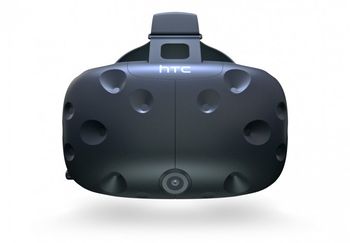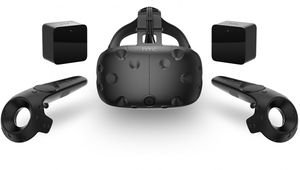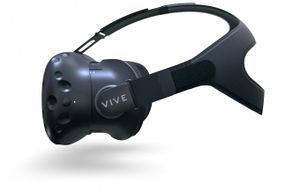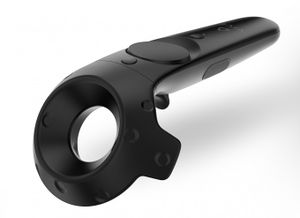HTC Vive
| HTC Vive | |
|---|---|

| |
| Basic Info | |
| VR/AR | Virtual Reality |
| Type | Head-mounted display |
| Subtype | Discrete HMD |
| Platform | SteamVR |
| Developer | HTC, Valve |
| Release Date | April 5, 2016 |
| Price | $799, €899, £689 |
| Website | http://www.htcvr.com/ |
| Requires | PC |
| Predecessor | HTC Vive Pre |
| Successor | HTC Vive CV2 |
| System | |
| Operating System | Windows |
| Storage | |
| Display | |
| Display | Dual Panel |
| Resolution | 2160 x 1200 (1080 x 1200 per eye) |
| Pixel Density | 455.63 PPI per eye |
| Refresh Rate | 90 Hz |
| Image | |
| Field of View | 110° (diagonal) |
| Optics | |
| Optics | Fresnel Lenses |
| Tracking | |
| Tracking | 6DOF |
| Rotational Tracking | Gyroscope, Accelerometer, Laser Position Sensor |
| Positional Tracking | Beacons |
| Update Rate | ?? |
| Tracking Volume | 120°H x 120°V (over 21 feet range) |
| Latency | ?? |
| Audio | |
| Audio | Built-in headphones, external headphones |
| Camera | Pass-through camera |
| Connectivity | |
| Connectivity | 2 HDMI ports, 2 USB ports, 1 headphone jack |
| Device | |
| Input | Controllers in both hands |
| Cable Length | 5+ meters |
- See also: HTC Vive Developer Editions
HTC Vive also known as HTC Vive CV1 or simply as the Vive is the first consumer version of HTC Vive Virtual Reality HMD developed by HTC. It is part of the SteamVR ecosystem created by Valve.
Pre-orders for the Vive begins on February 29, 2016 for $799. Vive released on April 5, 2016. HTC Vive CV1 comes with the head-mounted display, 2 wireless, motion tracked controllers and 2 lighthouse beacon positional sensors that enable room-scale VR.
Features
Frontal-facing camera
Vive Phone Services - Connect the HMD to your smartphone via Bluetooth, allowing the user to make and take calls and send and receive messages.
Hardware
Design and Ergonomics:
The all-black HMD is sleek and sturdy. It is secured to the user's head with a harness-like series of straps. The user's face contacts the HMD with a soft and comfortable facial interface. The foam gasket part of the interface can be removed and replaced by lifting it from the velcro. Vive comes with 2 foam gaskets: the larger "Wide Face" and the smaller "Thin Face". The You can change the distance between the lenses to fit your IPD with the dial on the right side of HMD. Eye relief, the distance between the lenses and your eyes, can be adjusted with 2 gray dials that you can pull out and rotate to extend or retract either side of the HMD. This function allows the Vive to accommodate most glasses.
Display and Optics:
Vive features dual OLED panel displays of 1080 x 1200 per eye. The colors are vibrant, the resolution is adequate and the screen door effect is minimal. The only glaring flaw of Vive's display and optics system is the Fresnel artifacts. The artifacts are caused by Fresnel lenses' ridges which scatter light. They look similar to lens flares and are noticeable whenever there are high contract elements on the screen i.e. white text on a black background.
Tracking:
Voice and Audio:
Vive has a built-in mic but does not have built-in headphones. It comes with a set of earbuds.
Cables and Ports:
Specifications
System Requirements
Recommended
- GPU: NVIDIA® GeForce® GTX 970, AMD Radeon™ R9 290 equivalent or better
- CPU: Intel® i5-4590 / AMD FX 8350 equivalent or better
- RAM: 4 GB or more
- Video Output: HDMI 1.4, DisplayPort 1.2 or newer
- USB Port: 1x USB 2.0 or better port
- Operating System: Windows 7 SP1, Windows 8.1 or later, Windows 10
SteamVR Performance Test
SteamVR Performance Test is a benchmark software that checks if your system is ready for Vive. It checks your system's OS, GPU and CPU to see if it has the capability of running VR at 90 FPS and whether VR content can tune the visual fidelity up to the recommended level.
Setup Tutorial
Input Devices
Apps
HTC Vive CV1 is shipped with 3 free games: Job Simulator: The 2050 Archives by Owlchemy Labs, Fantastic Contraption by Northway Games and Tilt Brush by Google.
Connecting to Your Phone
Users can install the Vive mobile app on their phone from the App Store[1] or Google Play[2]. The apps enable your HTC Vive HMD to connect to your mobile phones through Bluetooth. It allows your Vive HMD to receive calls, texts and calendar reminders while your are in VR.
To make phone calls, users need to download the Vive software package [3] for their PC. Now when you receive a call or text, you'll be able to call back the individual through the Vive menu.
Developer
Tracking volume
- See also: Tracking volume
120°H x 120°V (>21 feet range)
History
February 29, 2016 - Pre-orders for HTC Vive CV1 begin.
April 5, 2016 - HTC Vive CV1 is officially released.




